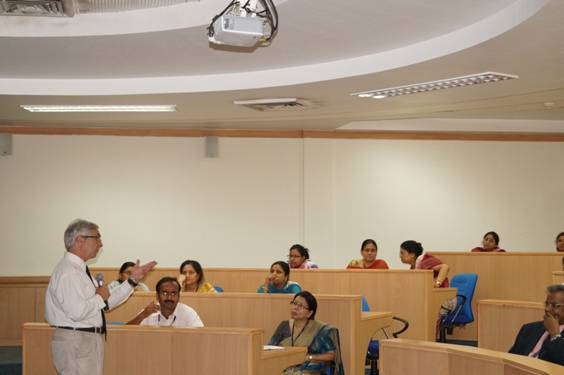23 Jul 2013|Noida | Amity University Campus, Sector-125 Noida
Prof. Andy Ogram, Professor Soil Microbiology, University of Florida - USA delivers lecture during ASTIF lecture series at Amity University

Prof. Andy Ogram, Professor Soil Microbiology, University of Florida delivered lecture on the topic “Competing process and mercury cycling in wetlands”. The special lecture was organized by Amity Science, Technology and Innovation Foundation under the ASTIF lecture series at Amity University, Sector-125.
Dr. Sunil Saran, Sr. Vice Chairman, ASTIF, Dr. R.P. Singh, Vice Chairman, ASTIF welcomed Prof. Andy Ogram.
Introducing the theme of his lecture, Prof. Andy Ogram said that Florida is a wet state with high rainfall rate having wet lands and marshes. University of Florida which is one of the biggest State University having around 50,000 students is doing pioneering research works in the area of methane and mercury found in the marshes of Florida. The Molecular Ecology Laboratory of the Soil and Water Science Department, University of Florida, is currently studying the microbial ecology of mercury methylating bacteria in the Everglades region of Florida, through grants from the National Science Foundation and DB Environmental, Inc (an environmental consulting firm in South Florida).
While giving a brief glimpse of Everglades, Prof. Orgram said that the Florida Everglades is a large freshwater marsh that covers much of the southern tip of the US state of Florida. The Everglades includes a national park and a series of water conservation areas that provide water for the large metropolitan centers of Florida, including Miami. The Everglades also provides numerous ecosystem services, including serving as the breeding grounds of the highly endangered Florida panther, numerous fish species and invertebrates, and many species of migratory water foul. Water quality of the Everglades is therefore of great importance to the maintaining the quality of life in South Florida, and Florida’s primary industry which is tourism. Prof. Ogram said that water in the Everglades contains phosphorus which leads in increase in primary productivity which leads to increase in microbial activity and biomass.
Prof. Orgram stated that the great concern to water managers and ecologists are the relatively high atmospheric deposition rates of inorganic mercury (Hg2+) in the Everglades. Hg2+ may be converted to methyl mercury (CH3Hg+) through the actions of a group of anaerobic microorganisms, most notably the sulfate reducing bacteria. Methyl mercury is a potent teratogen and neurotoxin that bio accumulates both through ecological food webs and in individuals through chronic exposure. Human consumption of certain fish species is banned in Everglades, and chronic exposure to methyl mercury has been implicated in changing the mating behaviors of wading birds.
Speaking about mercury, Prof. Ogram said that mercury is of global interest and is usually found in areas having fossil fuel like coal burning units or waste increnators facility. These units make elemental mercury into vapors which leads to mercury falling with raindrops and affecting the habitat of an area. In India, people living near coalmines have higher concentration of mercury in their body.
Dr. Sunil Saran said that incidences of diseases related to mercury in India are on the rise. The working conditions near the coal mines have to be improved so that the mercury exposure should be minimum for the workers and their family members.
Scientist, faculty from Amity Institute of Biotechnology, Amity Institute of Microbial Technology, Amity Institute of Nanotechnology and other Amity Institutions were present during the lecture session.